Product Description
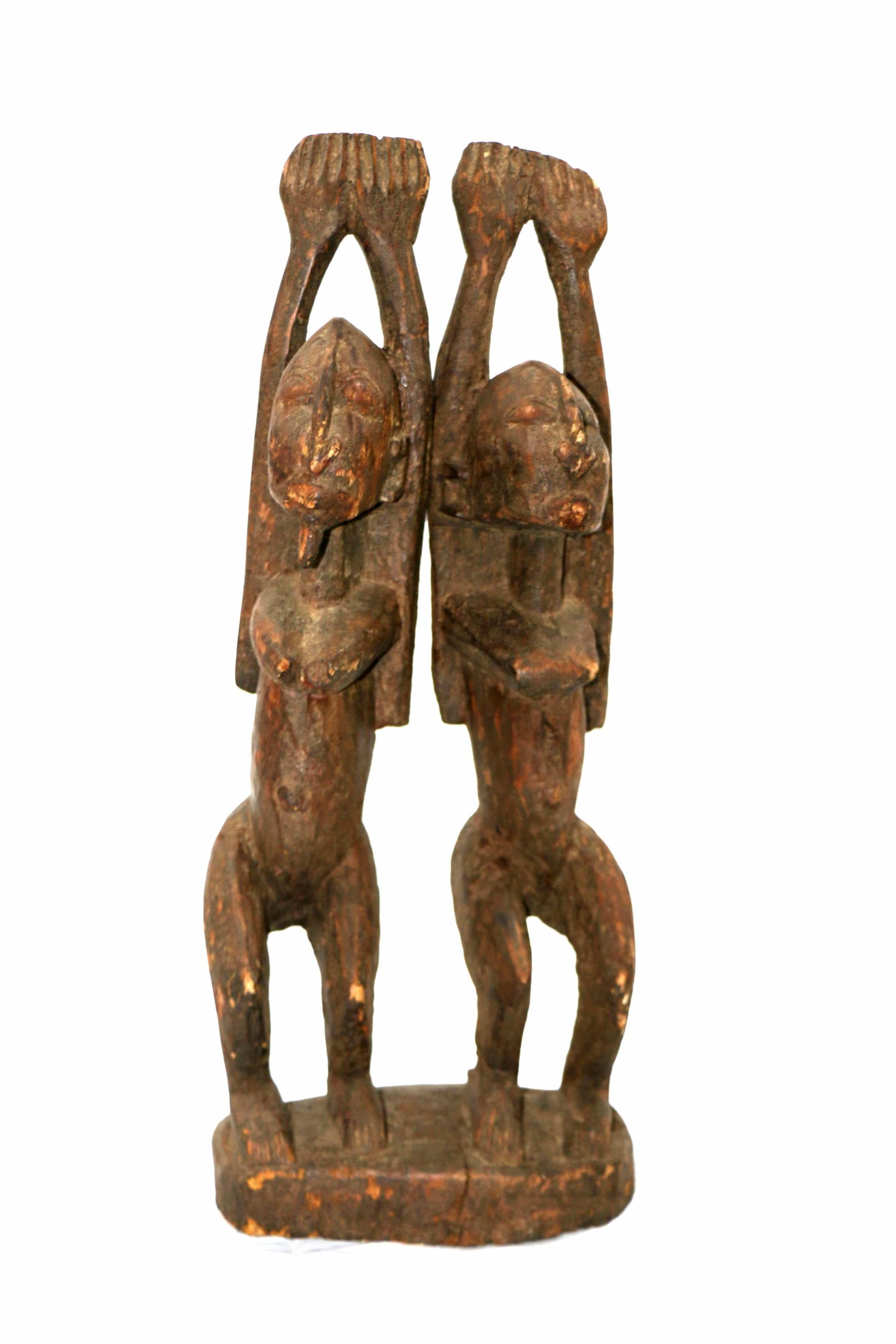

Dogon Ancestral Nommo Figure – Mali
This seated ‘Nommo style figure’ is carved from hardwood in the strict, clear, angular and abstracted ‘bombou-toro-style’ and originally from the Dogon people of Mali. Dogon figures are predominantly associated with the ancestor cult. Carved for personal or family use, they commemorate the foundation of a community and are worshiped by the villagers.
Made of 100% wood.
Model is W 53 – H 16 and weight 3.1 kg.
Description
This seated ‘Nommo style figure’ is carved from hardwood in the strict, clear, angular and abstracted ‘bombou-toro-style’ and originally from the Dogon people of Mali. Dogon figures are predominantly associated with the ancestor cult. Carved for personal or family use, they commemorate the foundation of a community and are worshiped by the villagers.
According to the origin myths of the Dogon, God ‘Amma’ created four pairs, the ‘Nommo’. As a ‘culture-maker’ for people. In the sculptural art of Dogon, these ‘Nommo’ are often portrayed. As a pair of figures, a female and a male, or even a bisexual hermaphrodite, that is a man and woman in a single figure. These ‘Nommo figures’ are placed on altars and ritually sacrificed (with millet and others). As one can see also the clear traces of prolonged sacrifice on the Dogon figure presented here. It is a stylistically very beautiful example, with some small and delicate, age-related cracks.
Although figurative sculptures, called dege, are perhaps the most interesting types of Dogon art, varied in form and rich in
imagery, they are also among the least well documented. Few altars have been described in detail or illustrated; those that have been
described do not suggest any consistent pattern linking a particular style of a figure or a specific posture or gesture with any one kind of altar.
There is also little information with which to identify the persons represented by the figures.
The Dogon an ethnic group are mainly located in the administrative districts of Bandiagara and Douentza in Mali, West Africa. The precise origins of the Dogon people, like those of many other ancient cultures, are not yet determined. Their civilization emerged, in much the same way as ancient Egypt. Around 1490 AD the Dogon people migrated to the Bandiagara cliffs of central Mali. There are approximately 700 Dogon villages, with an average of 400 inhabitants. The tribe’s folk call themselves ‘Dogon’ or ‘Dogom’, but in the older literature they are most often called ‘Habe’, a Fulbe meaning ‘stranger’. The Dogon have been described as the most studied and least understood tribal group in Africa. Their history, technology, cultural wealth, art and even oral legends are among the most involved in Africa, not least because the policy is in fact essentially artificial, comprising various sub-units that were grouped together on the basis of propinquity under the colonial administration. They are excessively prolific in terms of artistic production, not least because they have mastered all the main materials that are used in traditional African art; figures in stone, iron, bronze/copper and of course wood are all known, in addition to cave/rock painting and adaptation of more modern materials.
Additional information
| Weight | 3.1 kg |
|---|---|
| Dimensions | 16 × 53 cm |
Leave a reply Cancel reply
Returns and Exchanges
There are a few important things to keep in mind when returning a product you purchased.You can return unwanted items by post within 7 working days of receipt of your goods.
- You have 14 calendar days to return an item from the date you received it.
- Only items that have been purchased directly from Us.
- Please ensure that the item you are returning is repackaged with all elements.
Ship your item back to Us
Firstly Print and return this Returns Form to:
30 South Park Avenue, San Francisco, CA 94108, USA
Please remember to ensure that the item you are returning is repackaged with all elements.
For more information, view our full Returns and Exchanges information.
Related Products
This superb statue called "guardian byer", with its voluminous head and stocky appearance, is characteristic of the Southern Fang style, in particular, the Meke-Betsi of the North and the North - West Gabon. The character, in a sitting position, Holds in his hands an offering.
Made of 100% wood
Model is W 50 – H 20 and weight 2.4 kg.
This Dogon statue is hermaphrodite and originates from the Dogon and is called ‘Nommo sculpture’. Carved from hardwood in the strict, clear, angular and angular abstracted ‘bombou-toro-style’ and originally probably black-brown. She is identified as being a "Jonyeleni", a member of the Jo society, a woman's and men's initiation society among the Bamana.
Made of 100% wood.
Model is W 45 - H 48 and weight 1 kg.
This Dogon carved wood sculpture is a hunter holding two wands. The sculpture reflects the artistry, power, and authority of the Dogon artistry. Wooden sculptures have a special meaning for the Dogon for they blend symbol and a powerful aesthetic in a very abstract image.
Made of 100% wood.
Model is W 23 – H 72 and weight 2 kg.
This Magnificient Bamana ChiWara carving originates from the Bambara tribe in Mali. The patina is rich and the surface shows significant signs of age. The mythology of the Bamana people of Mali tells the story of an antelope named Chi Wara who first taught farming skills to humanity.
Made of 100% wood.
Model is W 22 - H 68 and weight 8 kg.
This rare articulated Anthropomorphic Iginga doll made of wood originates from the Lega/Bwami peoples of the Democratic Republic of the Congo. Figures such as this were used as a didactic device during the ritual of the Bwami Society to educate young initiates. Their metaphoric form help instructors to pass the message as do the proverbs, legends, myths and slogans.
Made of 100% wood, vegetable fibers.
Model is W 60 - H 24 and weight 5.5 kg.
This rare and beautiful 19th–mid-20th century mother-and-child maternity figure carved for the Royal Court originates from northeastern Igboland, Nigeria. The Shango crest sits on atop the head, with ethnic adornments and scarification and exceptional detail in the facial expression. Shango is the god of thunder and lightning. Shango is both feared in the context of justice and magic and venerated as his manifestations bring beneficial rain for crops.
Made of 100% wood.
Model is W 75 - H 16 and weight 5.2 kg.
This beautiful standing sculpture of a woman holding a child and staff is hermaphrodite and originates from the Dogon. The maternity figure evokes stature, with its long neck, great dignity, hierarchy. The style, known as Bombou-Toro is believed to represent the ideals of beauty, fertility, commonly used as shrine figures. They were often objects of petitions or prayers for fertility and successful births.
Made of 100% wood.
Model is W 68 - H 16 and weight 3.2 kg.
This beautiful Dogon seated woman holding a child is hermaphrodite and originates from the Dogon. It has evokes stature, with its long neck and great dignity, hieratic. Very nice patina, old wood. The style is known as Bombou-Toro, which is characterized by slender proportions, with detailed and delicate features, and are believed to represent episodes from Dogon mythology.
Made of 100% wood.
Model is W 51 - H 17 and weight 4.8 kg.
This authentic, well preserved Bronze of the Benin Kingdom in what is now Nigeria exhibits a virtuosity and sophistication of style that has astonished the Western world since they were visited in the 15th century. The figure and pose are classic from the high period of Benin art in the 15th century and honor the King or Oba.
Made of 100% Bronze
Age Mid 15th Century
Model is W 53 – H 15 and weight 5.3 kg.
This ancestral Mangbetu mother-child figure made of light wood, fiber Patin, is an exceptional piece for your collection. It originates from the Mangbetu also spelled Monbuttu, peoples of Central Africa living to the south of the Zande in northeastern Congo (Kinshasa). The Anthropomorphic figure dates from 1950 - 1960.
Made of 100% light wood, fiber Patin.
Model is W 76 - H 21 and weight 4.5 kg.
This old Dogon 'Nommo sculpture' is female. Carved from hardwood in the strict, clear, angular and angular abstracted 'bombou-toro-style' and originally probably black-brown.This kind of wooden statue was commonly used as shrine figures, in order to ensure births and prosperity to the village.
Made of 100% wood.
Model is W 37 - H 9 and weight 0.8 kg.
This hand-carved anthropomorphic figure comes from the Ivory Coast/Mali and is called Tugubele. It has preserved its authenticity, surface, and aged patina. The wood carving is exquisite and exaggerated features, have all of the hallmarks of the Senufo people.
Made of 100% wood
Model is W 72 – H 23 and weight 0.5 kg.
This rare Wurkun (or Bikwin) small figure, in a post or staff-like form, is known as iagalagana and incarnates tutelary spirits. The stylized figure is stuck on iron rods, with a beautiful crusty red ocher patina. These statues were frequently washed with liquid clay, "fed" with millet beer offerings, rubbed with oil, explaining the thickness of the clay.
Made of 100% Iron, Paint.
Model is W 41 - H 14 and weight 3.5 kg.
This superb statue called "Eyema Byeri, guardian byer, with its voluminous head and stocky appearance, is characteristic of the Southern Fang style, in particular the Meke-Betsi of the North and the North - West Gabon. The character, in a sitting position, holds with both hands the ceremonial flute for initiated So, young boys rite of passage among the Beti-Fang.
Made of 100% wood Model is W 62 – H 24 and weight 4 kg.
The present Anthropomorphic figure, known as Bamana (Jonyeleni), female seated figure on a stylized stool, originates from the artistic tradition of the Bamana. A tradition rich, filled with pottery, sculptures, beautiful bokolanfini cloth, and wrought iron figures fashioned by blacksmiths.
Made of 100% wood, dark patina.
Model is W 69 - H 1 and weight 4.5 kg.
This authentic, free-standing brass head cast in the lost wax technique of the Benin Kingdom, in what is now Nigeria, exhibits a virtuosity and sophistication of style that has astonished the Western world since they were visited in the 15th century. The face's shape and unique expression, a tranquil and dignified presence with the transcendent gaze clearly indicate qualities of genuine nobility: endurance, far-sightedness, determination, and wisdom.
Made of 100% Copper
Age late 14th-early 15th century
Model is W 40 – H 26 and weight 5 kg.
This finely carved bronze figure represents a dwarf at the court of Benin. Wearing courtly dress in continuation of the traditional bronze art of Benin in form of a bearded person with o-shaped legs and neck adornment. In Edo culture dwarfs were known as the jugglers and acrobats in the Oba court.
Made of 100% Bronze
Model is W 46 – H 22 and weight 5 k
This young Fang "Eyema Byeri" figure of a male ancestor is characteristic of the style of the Fang Ntumu subgroup of northern Gabon near the Cameroon border. The appearance of Fang reliquary figures varies greatly from region to region. The Fang characteristics are recognized by the accentuated muscular reliefs of the arms and calves, as well as the curved shoulders and thighs. A good illustration of the “classical” style of the Southern Fang with a concave-convex face.
Made of 100% wood
Model is W 10 – H 43 and weight 1 kg.
This ancestral Mangbetu statue is an exceptional piece from the Mangbetu also spelled Monbuttu, peoples of Central Africa living to the south of the Zande in northeastern Congo (Kinshasa). The Anthropomorphic figure dates from 1950 - 1960.
Made of 100% light wood, fiber Patin.
Model is W 72 - H 231 and weight 5.5 kg.
This old Dogon maternity figure is a fine work of art. It represents the mythical ancestor and symbolically the feminine ideals of beauty and fertility. This kind of Dogon statue was commonly used as shrine figures and kept on a Binu shrine in the village, in order to ensure successful births, fertility, and prosperity to the village.
Made of 100% wood.
Model is W 7 - H 46 and weight 1 kg.
This miniature Cast Handmade Dogon iron sculpture is a farmer or shepherd holding a wand. The sculpture reflects the artistry, power, and authority of the Dogon blacksmith. Iron sculpture has a special meaning for the Dogon for they blend symbol and a powerful aesthetic in a very abstract image.
Made of 100% Brass, Iron Alloy
Model is W 27 – H 8 and weight 0.07 kg.
This mini figure is characteristic of the Southern Fang style, in particular, the Meke-Betsi of the North and the North - West Gabon. It is called "Eyema Byeri " or Guardian Byer". It has a voluminous head and a stocky appearance, in a sitting position, and holds with both hands the ceremonial flute So initiates, boys rite of passage among the Beti-Fang. These types of figures are recognized by the accentuated muscular reliefs of the arms and calves, as well as the rounded-shoulders and thighs (the fixation rostrum on the nsekh-byeri reliquary has disappeared).
Made of 100% wood
Model is W 20 – H 7 and weight 0.8 kg.
This beautiful Bombou-Toro statue of a woman standing holding a child is hermaphrodite and originates from the Dogon tribe of Mali. It evokes stature and represents a maternity figure, ‘mother and child’ or original founding primordial beings who gave the Dogon birth, also referred to as Nummo. They were often objects of petitions or prayers for fertility and successful births.
Made of 100% wood.
Model is W 17 - H 71 and weight 4.1 kg.
The present figure, known as Janus Merekun, is a puppet masquerade drama of the Bamana. The Sogo bò puppet theater is still widely used in the Bamana tribe and goes back to the old tradition of neighboring Bozo. This piece shows distinct stylistic traits of the Bozo and therefore can not be precisely delineated.
Made of 100% wood, dark patina.
Model is W 50 – H 11 and weight 1 kg.
This authentic, well preserved Bronze of the Benin Kingdom is usually seen as a court official whose job it was to herald the arrival of the Oba's royal entourage with the blow of his horn during public processions. The hornblower wears luxurious clothing and is therefore more likely dressed for a specific festival or celebration than for a war.
Made of 100% Bronze
Age Mid 15th Century
Model is W 60 – H 13 and weight 7.5 kg.
This beautiful hand-carved figure originates from the Senufo people of Ivory Coast, Mali, and Burkina Faso. The figure is called Senufo Rhythm Pounder. It has preserved its authenticity, surface, and aged patina. The wood carving is exquisite and exaggerated features, have all of the hallmarks of the Senufo people.
Made of 100% wood
Model is W 6 – H 68 and weight 1 kg.
This beautiful female hand-carved figure is called "Rhythm Pounder". It originates from the Senufo people of Ivory Coast, Mali, and Burkina Faso. The anthropomorphic figure was once a benevolent symbol of fertility and a conduit to the departed, but also a crucial prop in both commemorative ancestral rites and in initiations of adolescents to adult society. It has preserved its authenticity, surface, and aged patina. The wood carving is exquisite and exaggerated features, have all of the hallmarks of the Senufo people.
Made of 100% wood
Model is W 20 – H 112 and weight 5 kg.
This small, late 19th–early 20th century, Maginga statue made of wood originates from the Lega peoples of the Democratic Republic of the Congo. The figure portrays angular legs tapering to the torso with protruding navel framed by truncated arms, the sloping shoulders supporting the head with scooped, heart-shaped facial plane, notched mouth and coffee-bean eyes; covered in kaolin.
Made of 100% wood, kaolin, vegetable fibers.
Model is W 51 - H 16 and weight 1.9 kg.
The “guardian Byer”, is characteristic of the Southern Fang style, in particular, the Meke-Betsi of the North and the North – West Gabon. The character in a sitting position, with its voluminous head and stocky appearance, holds in his hands the ceremonial flute So initiates, boys rite of passage among the Beti-Fang.
Made of 100% wood
Model is W 14 – H 51 and weight 2.3 kg.
The present figure, known as Janus Merekun, is a puppet masquerade drama of the Bamana people of Mali. The Sogo bò puppet theater is still widely used in the Bamana tribe and goes back to the old tradition of neighboring Bozo. This piece shows distinct stylistic traits of the Bozo and therefore can not be precisely delineated.
Made of 100% carved wood, metal.
Model is W 6 – H 79 and weight 1.3 kg.
This superb statue called "guardian byer", with its voluminous head and stocky appearance, is characteristic of the Southern Fang style, in particular the Meke-Betsi of the North and the North - West Gabon. The character, in a sitting position, Holds in his hands an offering.
Made of 100% wood
Model is W 62 – H 24 and weight 4 kg.
This Ancestral Figure originates from Dogon. Carved for personal or family use, they commemorate the foundation of a community and are worshiped by the village. This type of art object with such a quality of achievement and a wood so old is rare. The figure is normally placed on an altar and most of which are dedicated to ancestors, either real or mythical.
Made of 100% wood, Kaolin pigments.
Model is W 14 - H 26 and weight 2 kg.
This unique clay small sculptures of a couple was sculpted by creative and skillful artisan of the Djenne tribe in the West African Republic of Mali. The art of the inner delta of the Niger, the region formed by the triangle of the cities of Mopti, Ke Macina, and Djenne, bears witness to an astonishing richness of invention and a lively concern with detail.
Made of 100% Terracotta
Model is W 38 – H 7 and weight 0.8 kg.
This large Dogon statue of a woman standing carrying a child on her back and holding a calebasse is hermaphrodite and originates from the Dogon. The maternity figure represents one of the ‘mother’ or original founding primordial beings who gave the Dogon birth, also referred to as Nummo.
Made of 100% wood, crusted Patina, Kaolin..
Model is W 91 - H 20 and weight 13 kg.
This superb statue called "guardian byer", with its voluminous head and stocky appearance, is characteristic of the Southern Fang style, in particular, the Meke-Betsi of the North and the North - West Gabon. The character, in a sitting position, with its hand on hips.
Made of 100% wood
Model is W 50 – H 11 and weight 2 kg.
This small Kunin sculpture, from the Middle Benue River Valley, Nigeria, is distinguished by its overall elegant proportions and stylistically compared to their Mumuye and Jukun neighbors. The Chamba venerate anthropomorphic statues of male and female gender. The figure is not very common and their role is little known but it has been reported that there figures are used in a cult activity known as Jup that is in the main dominated by men or in the case of women, Jem.
Made of 100% carved wood, patina.
Model is W 8 - H 67 and weight 1.7 kg.
This fantastic Chamba statue, is not very common and has an exceptional aesthetic presence and compelling abstract design. It was thought to have either a protective or healing function for the Wurkun or Bikwin peoples of the Benue River Valley.
Made of 100% carved wood and camwood powder.
Model is W 60 – H 14 and weight 3 kg.
Hermaphrodite figure originating from the Dogon people of Mali. Often Dogon figures recreate the hermaphroditic mythology of their beliefs. The maternity figure represents one of the ‘mother’ or original founding primordial beings who gave the Dogon birth, also referred to as Nummo.
Made of 100% wood
Model is W 16 – H 56 and weight 3.4 kg.
Ancestor' Mangbetu figure box, originating from the Mangbetu peoples of Central Africa living to the south of the Zande in northeastern Congo (Kinshasa). They are believed to be ancestral portraits of Mangbetu royalties, and were used to decorate thrones, and likely placed in a shrine to honor them.
Made of 100% light wood, fiber Patin.
Model is W 40 - H 19 and weight 3 kg.
This female figure holding a child is a Dogon hermaphrodite originating from the Dogon Tribe of Mali. With its long neck and great dignity, it evokes a hierarchical status. The style is known as Bombou-Toro. Maternity figures depict the ideals of beauty, fertility, commonly used as shrine figures. They were often objects of petitions or prayers for fertility and successful births.
Made of 100% wood.
Model is W 12 - H 80 and weight 4 kg.



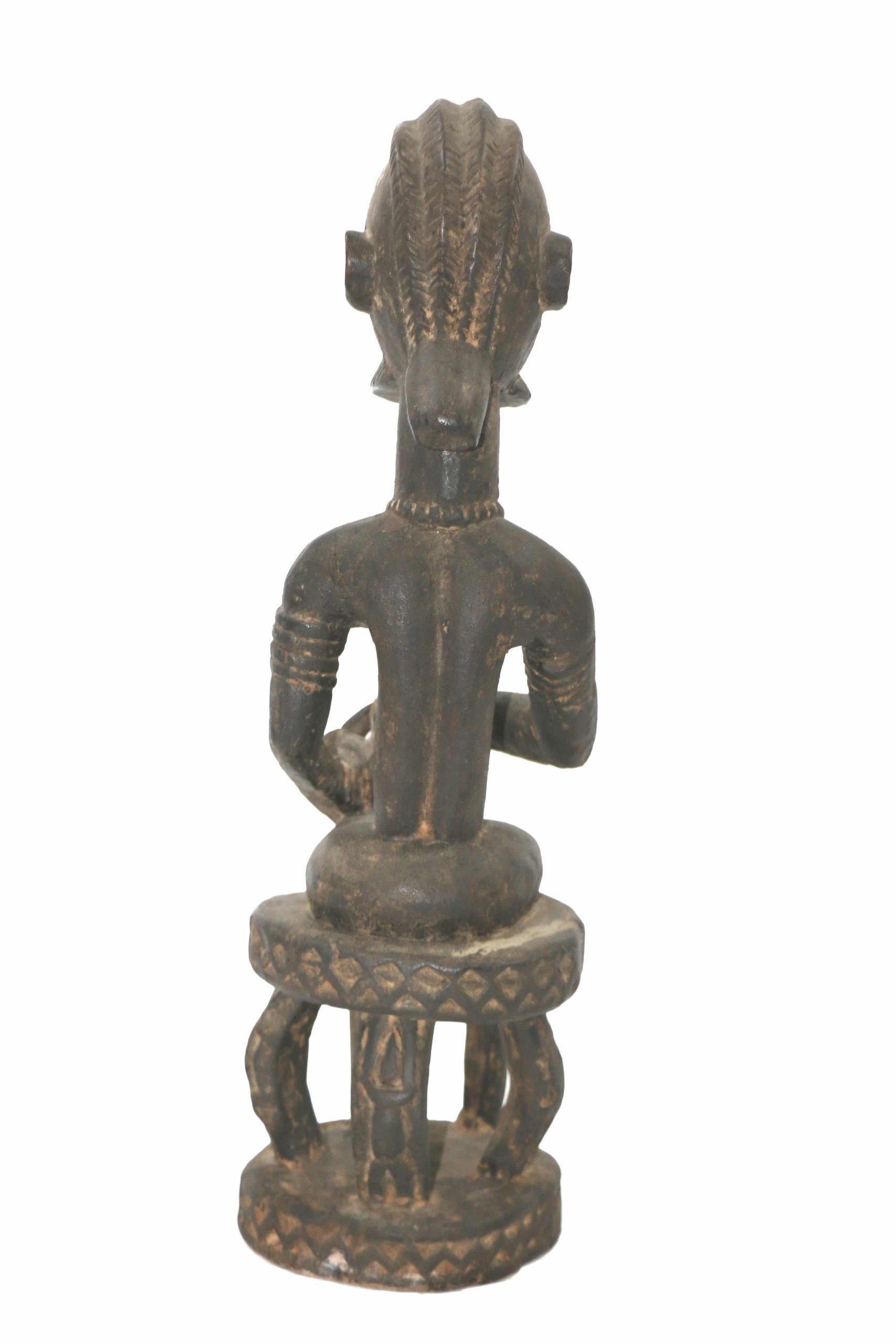
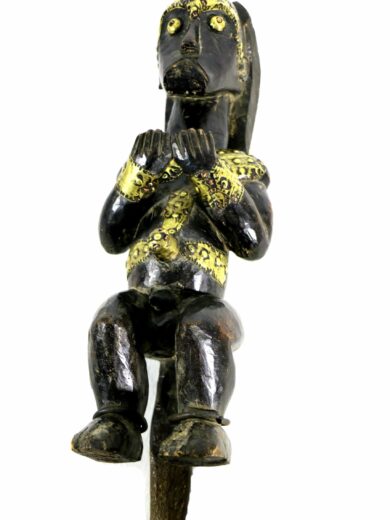
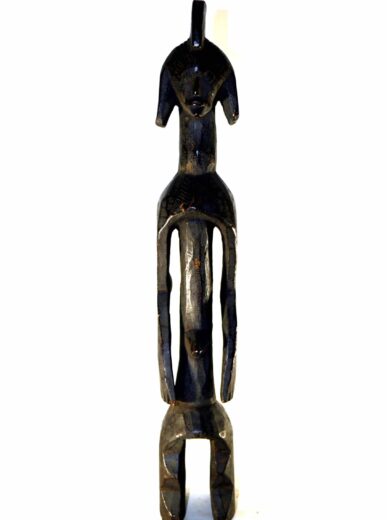
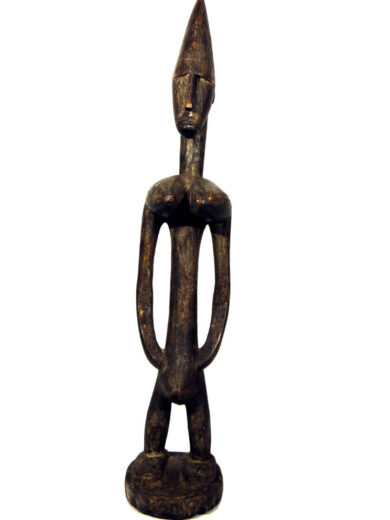
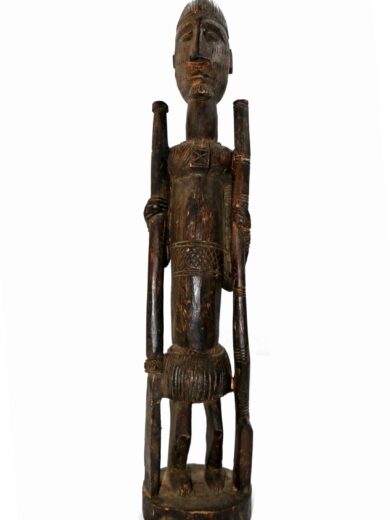
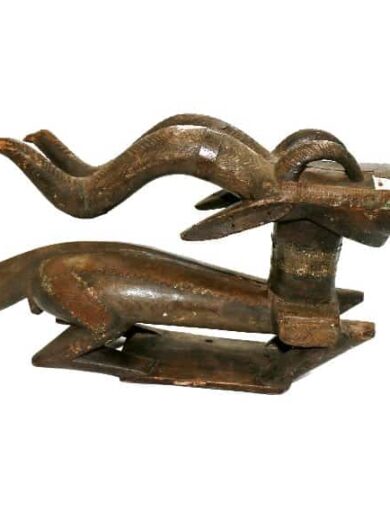
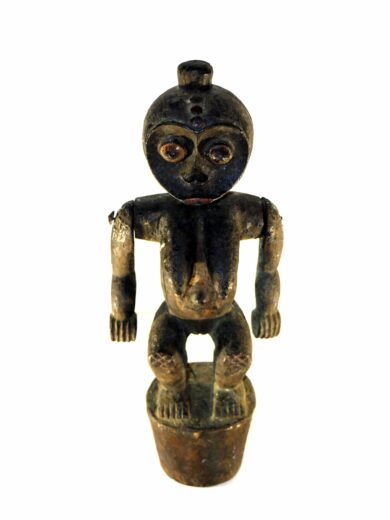
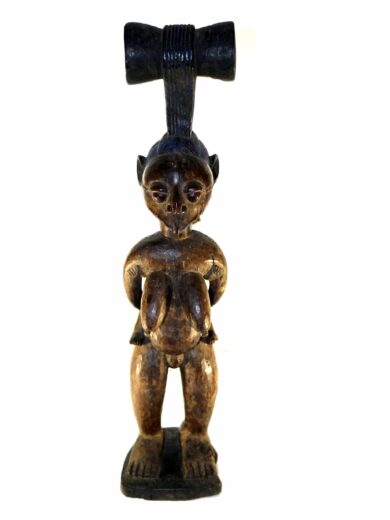
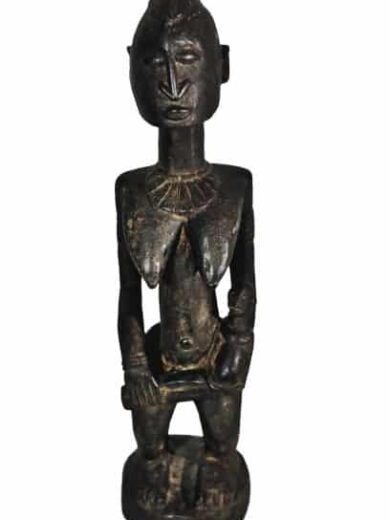
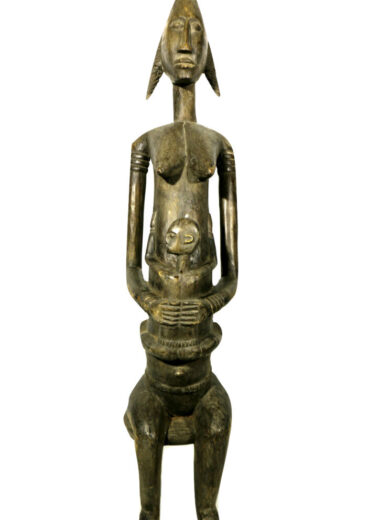
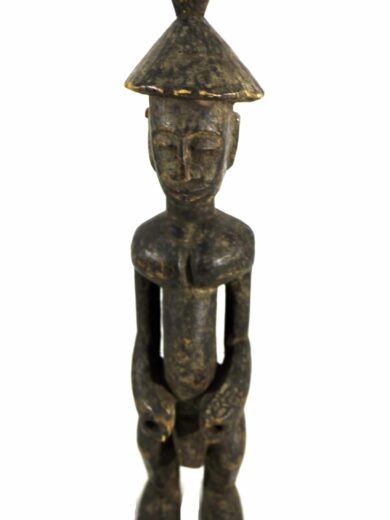
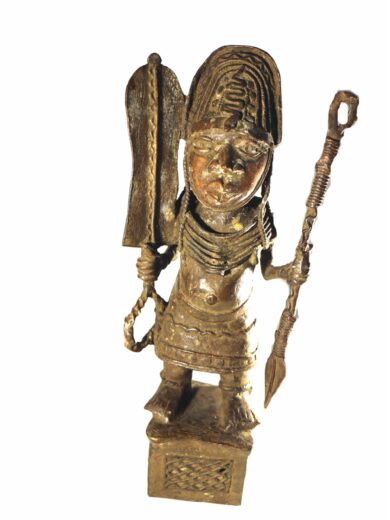
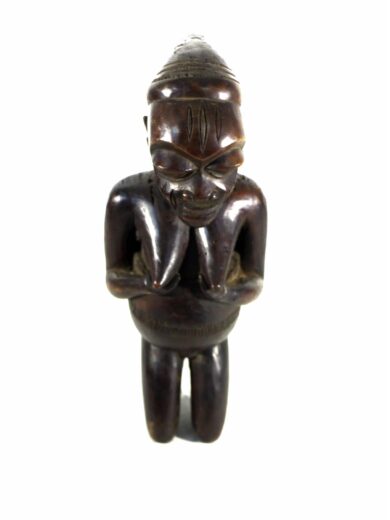
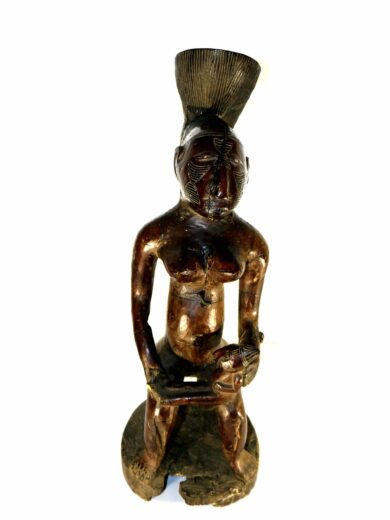
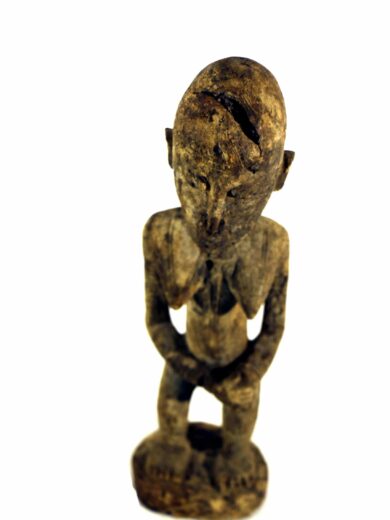
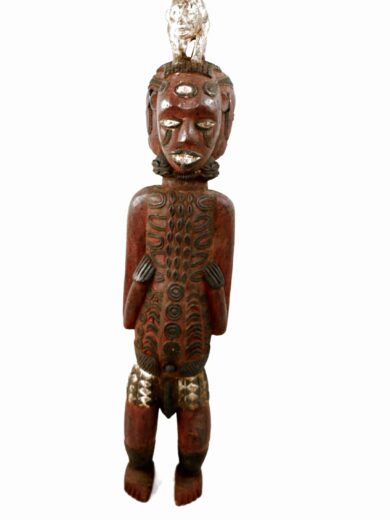
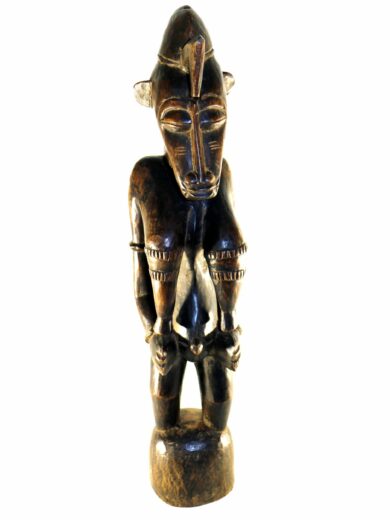
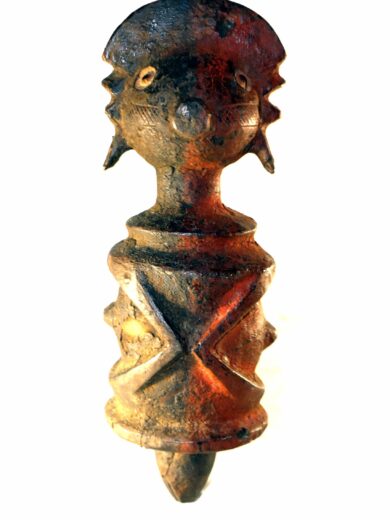
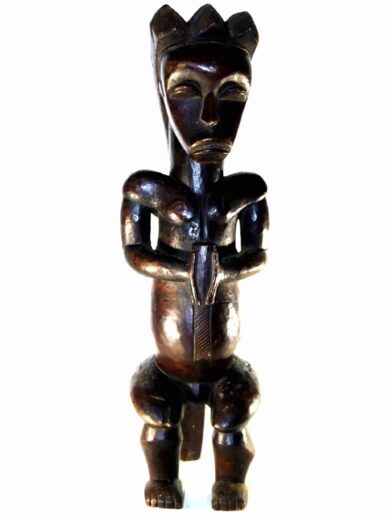
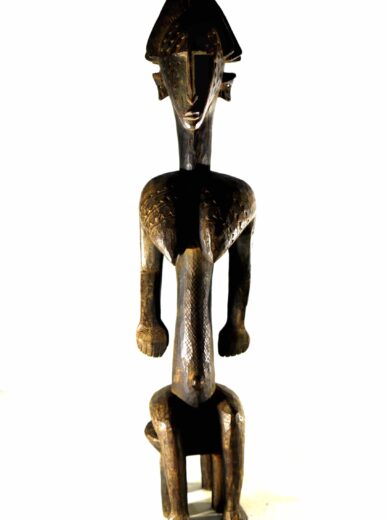
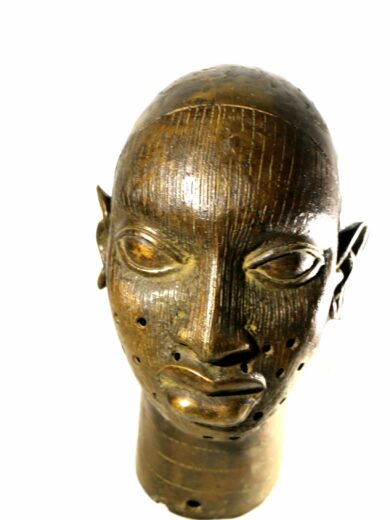
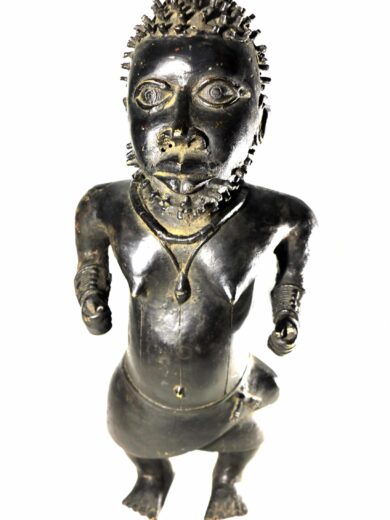
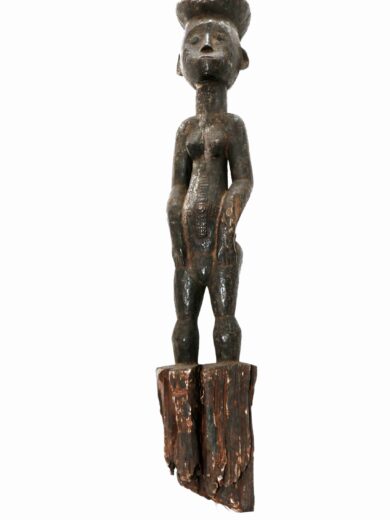
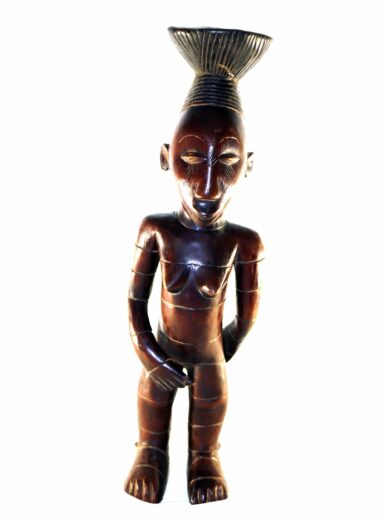
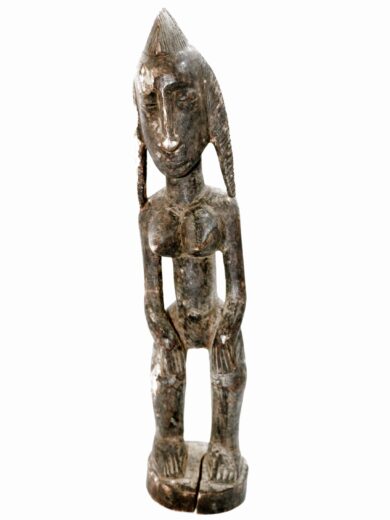
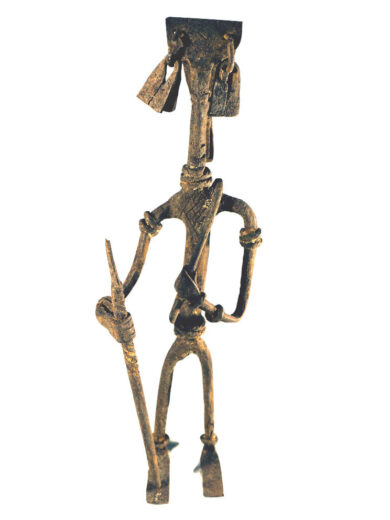
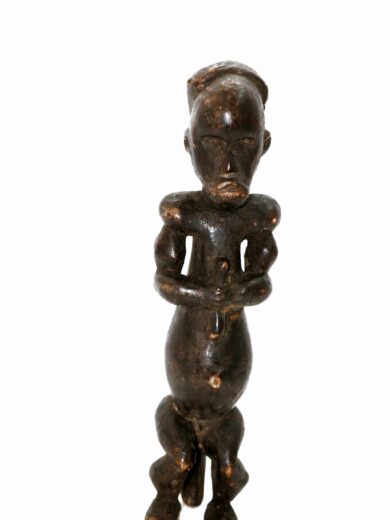
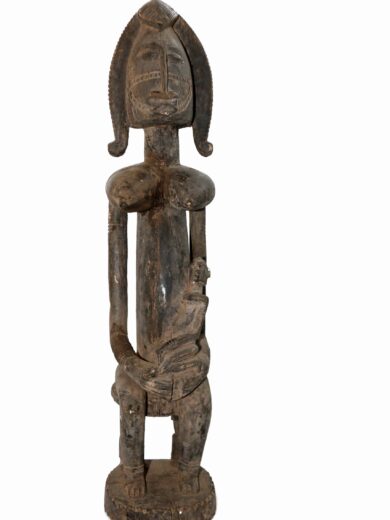
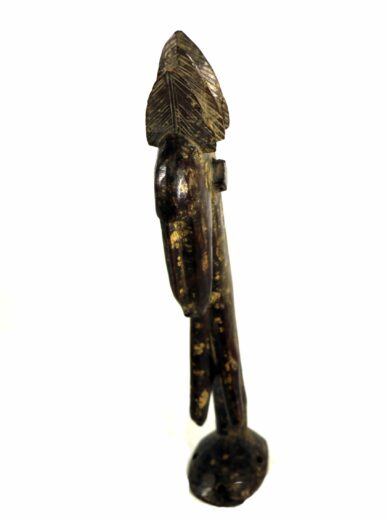
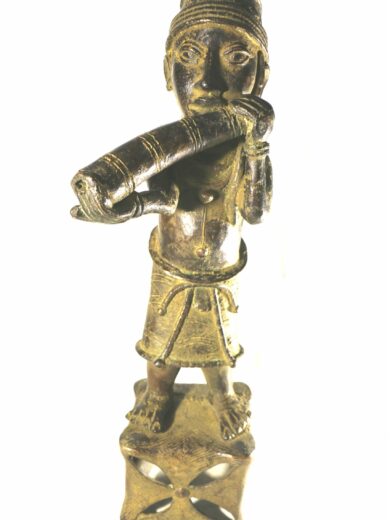
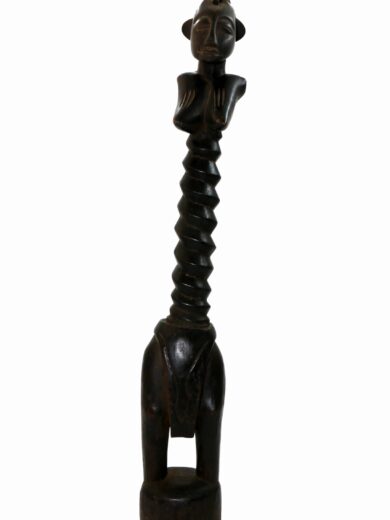
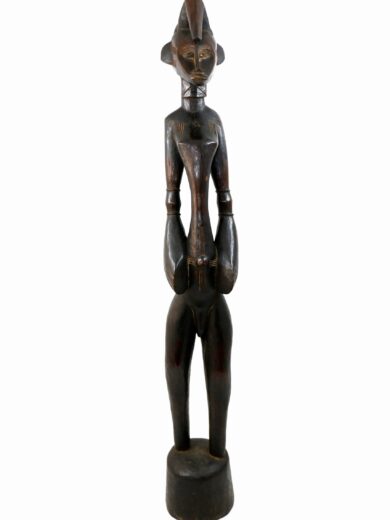
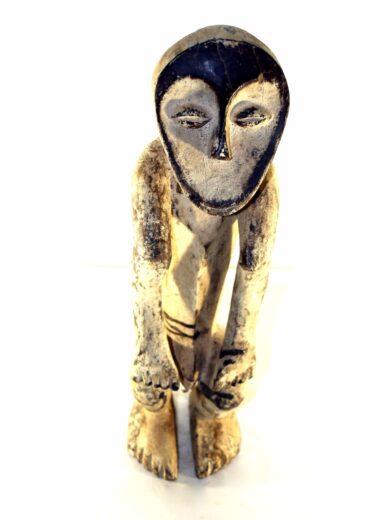
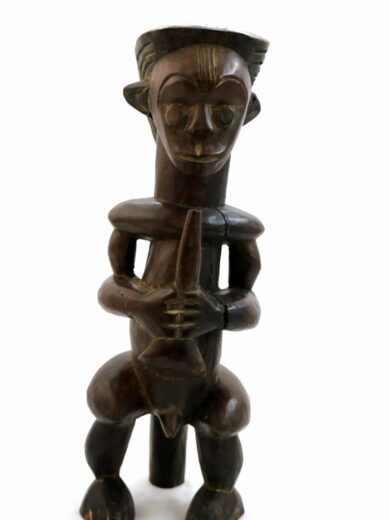
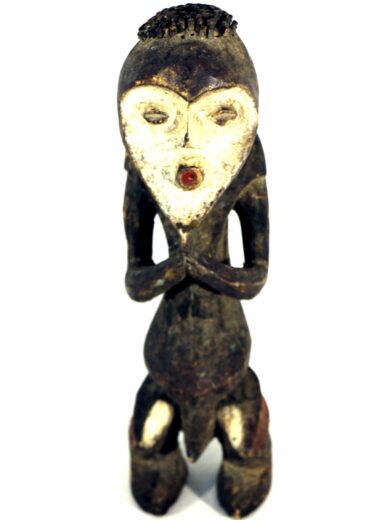
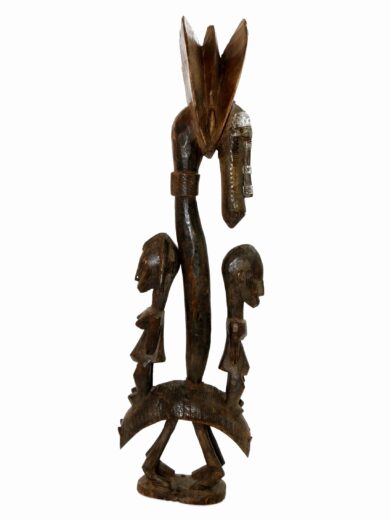
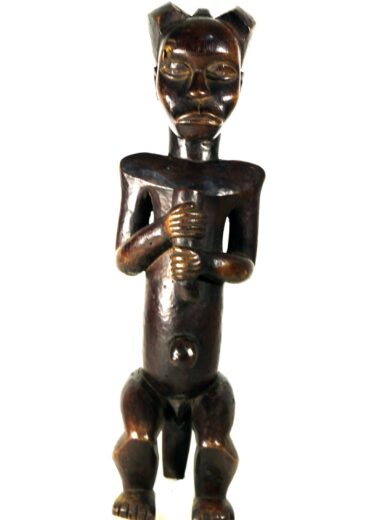
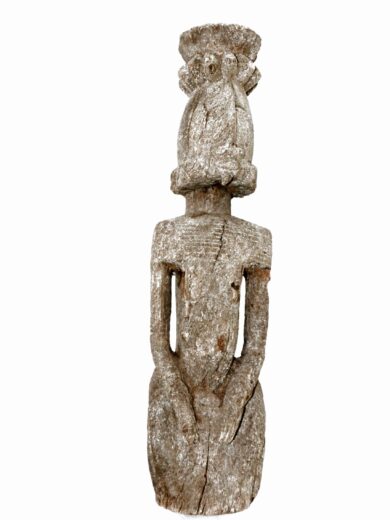
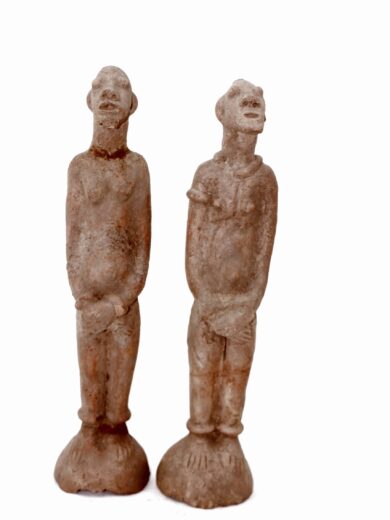
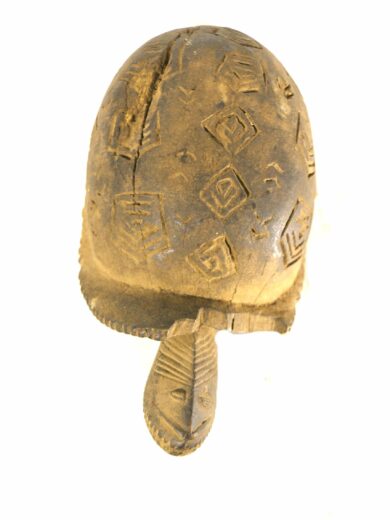
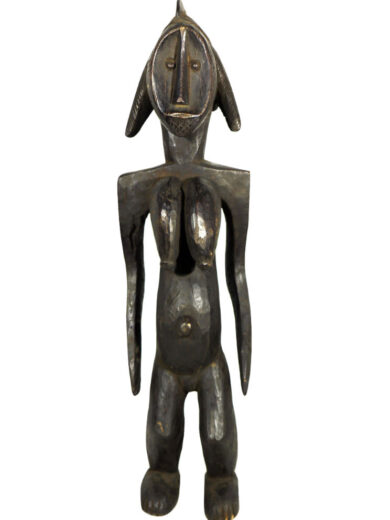
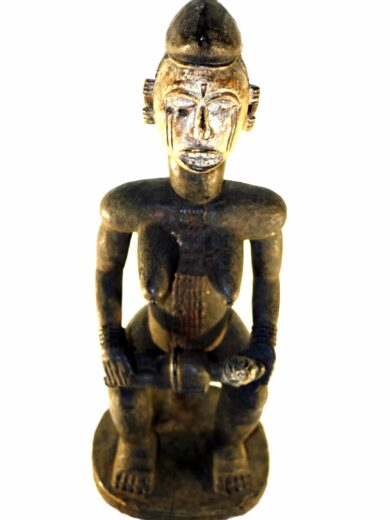
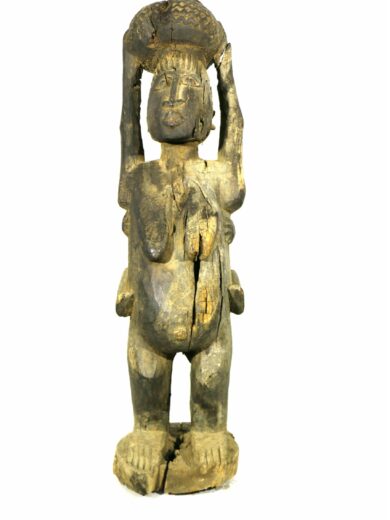
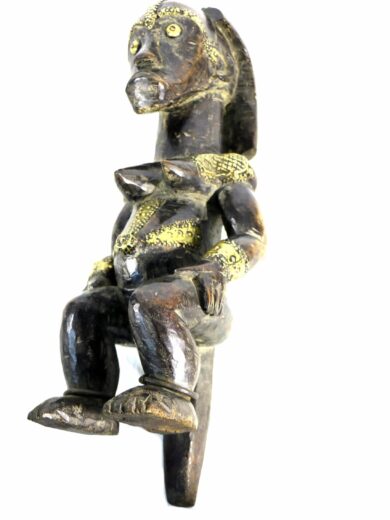
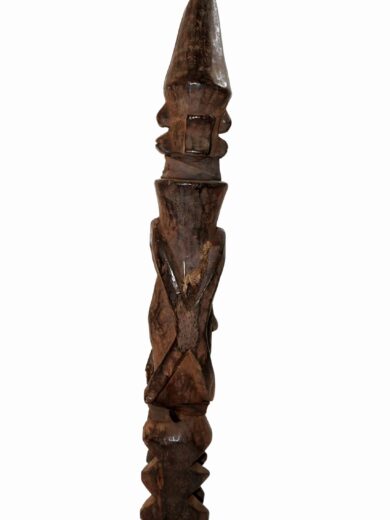
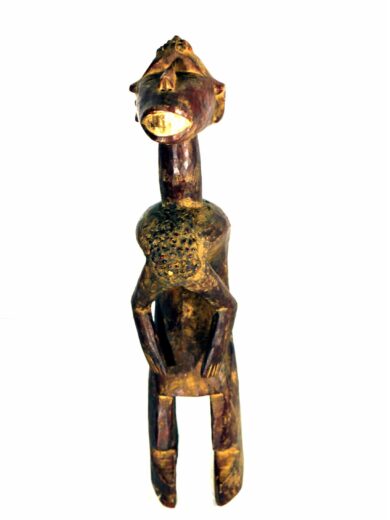
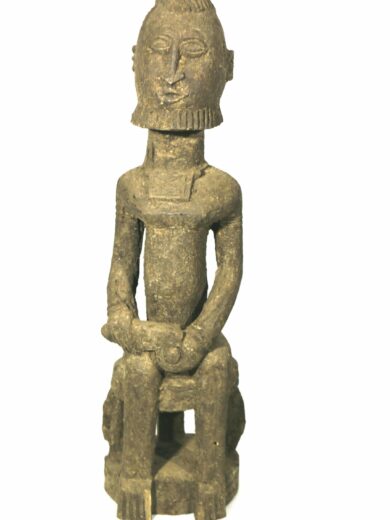
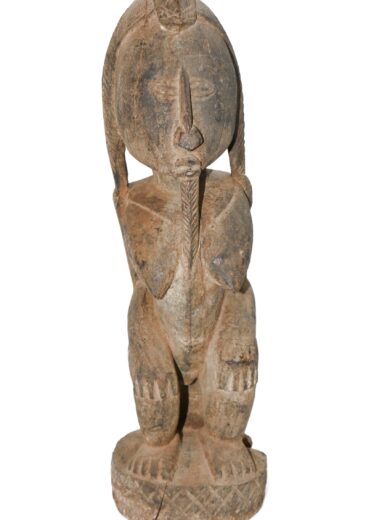
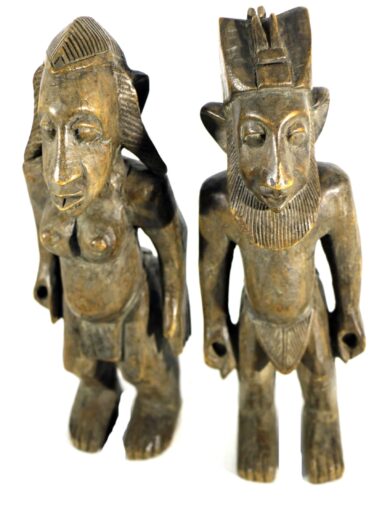
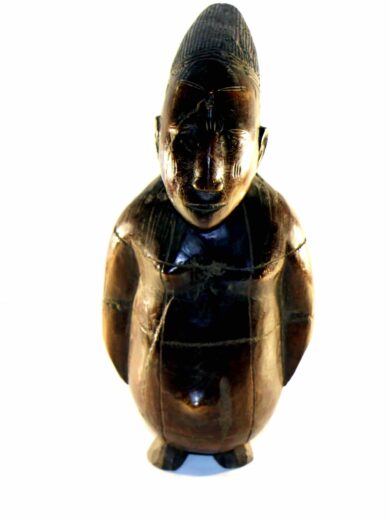
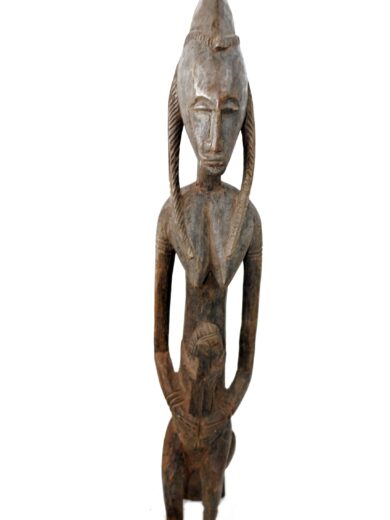

Reviews
There are no reviews yet.